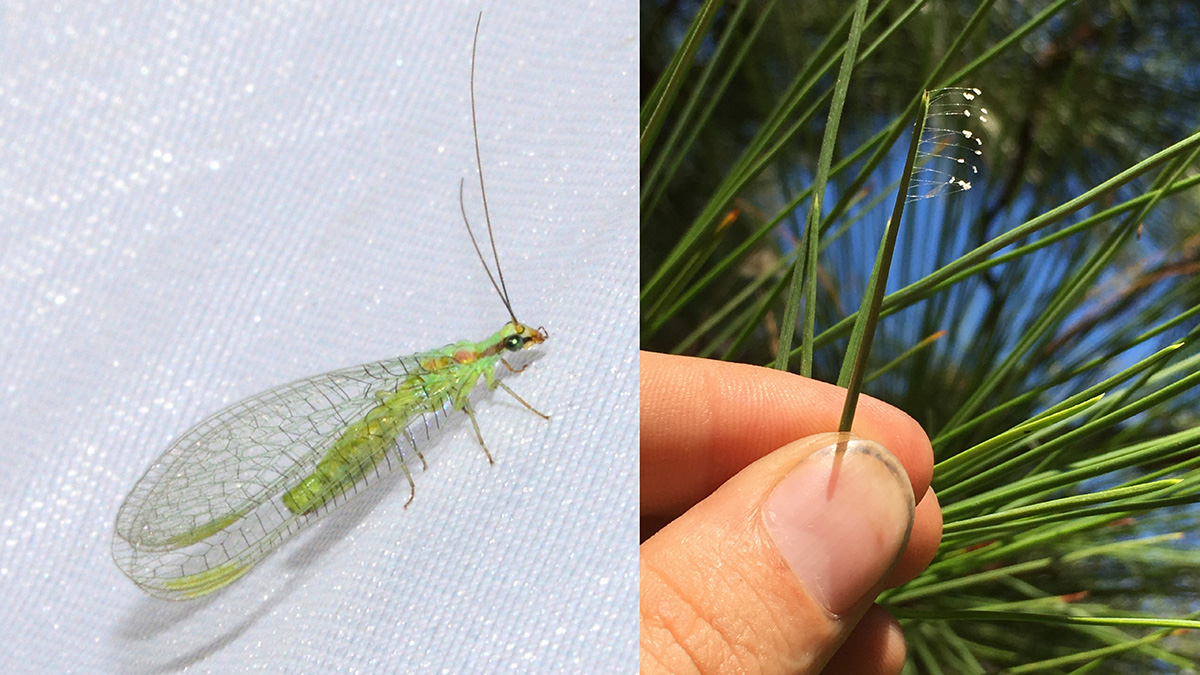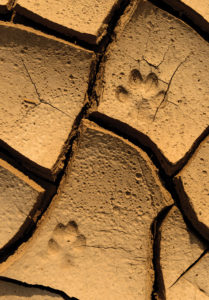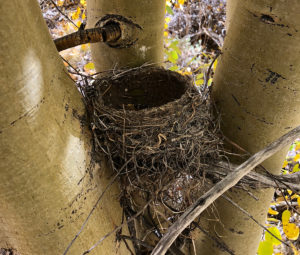I found this on my front door — it looks like needles in a circular motion with white tips. What is it?

The small “needles” that start to decorate doors, plants, and just about any surface imaginable this time of year are from an often overlooked family of insects known as the green lacewings (Chrysopidae). These insects, as many gardeners are probably aware, are voracious predators of aphids, mites, whiteflies, and other small soft bodied insects. Many garden supply stores will sell them right alongside ladybugs as beneficial beasts for your home garden. If you are ever lucky enough to encounter a lacewing, they are some of the most subtly dazzling insects of the Bay Area, with large round eyes that reflect light like a kaleidoscope set against a uniformly green body and a set of clear wings trimmed with green veins.
The eggs are a remarkable adaptation to predation and some really cool chemistry in action. Lacewing larva enjoy feasting on the sugary-juice-bags of the insect world known as aphids. Unfortunately for their predators, aphids have a long-standing deal — some call this mutualism — with rough-and-tough ants that fend off aphid predators in exchange for some sweet sugary honeydew drops out of the backside of the aphids. Ants are really good at finding food sources and exploiting them. If you are an adult lacewing and hoping to give your offspring a head start you would like to hatch them close to aphids, but if those pesky ants are around they will surely find your eggs and devour them. Lacewings evolved a way to deal with this conundrum which is to lay eggs at the tips of tiny silken threads. The egg-stalks are just tall enough that ants have a hard time finding the eggs and a number of lacewings also lace these egg-stalks with chemical defenses.

Silk is the term used to describe a number of naturally produced protein fibers that can be made by many different organisms and have varying protein compositions. The most famous silk comes from moths, but spiders, beetles and even some bees can make silk. Lacewings produce two different types of silk. The silk used for egg-stalks is rigid due to protein motifs known as beta-sheets being perpendicular to the fiber axis. This novel arrangement for a silk fiber gives the lacewing silk a rigidness not seen in other silks and is what allows the eggs to stick up right on any surface it gets attached to. Between the larval stage and the adult, the insect pupates in a silken cocoon of a very different fiber. The cocoon silk is composed of a much larger protein and the fibers are about twice as thick. These cocoon silk fibers readily act as a scaffold for lipids (fats) that are used inside the cocoon to make an internal chamber for retaining moisture.
The best way to see adult lacewings is to hang out by light sources at night. They fly mainly at night and like moths are attracted to lights in the blue and UV spectrums. If you are looking to see the egg-stalks your best bet is to find an area with aphids and then start checking the underside of leaves as this seems to be a favorite hiding spot of a clutch of eggs.

Ask the Naturalist is a reader-funded bimonthly column with the California Center for Natural History that answers your questions about the natural world of the San Francisco Bay Area.




